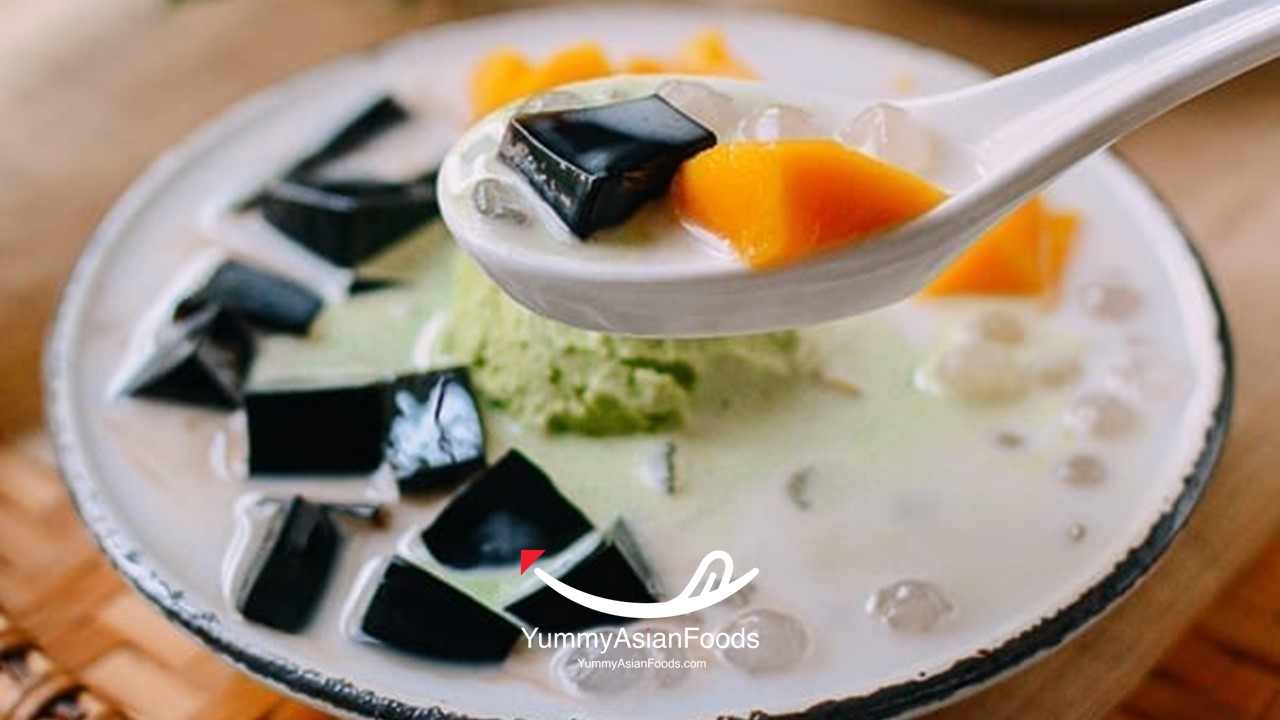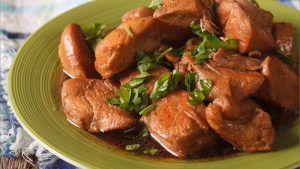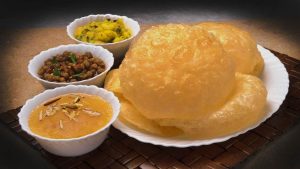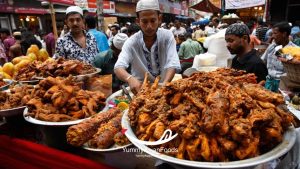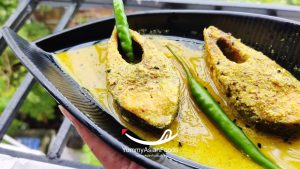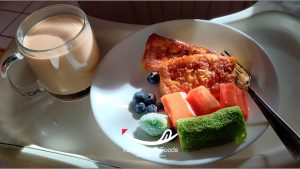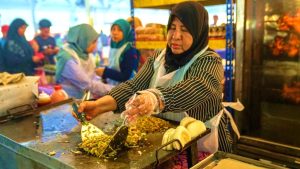Table of Contents
ToggleWelcome to our latest blog post, where we embark on a delectable journey into the world of Chinese desserts. Desserts in China are gaining popularity worldwide due to their unique flavors and delightful combinations of ingredients. In this post, we aim to explore 11 mouthwatering Chinese dessert treats that will tantalize your taste buds and leave you craving more. So, prepare to satisfy your sweet tooth as we delve into the irresistible world of Asian sweet treats.
1. Sweet Rice Balls (Tang Yuan) Chinese Dessert
Tangyuan, also known as sweet rice balls, is a traditional Chinese dessert that holds great significance in Chinese culture, particularly during the Lantern Festival. These round and colorful glutinous rice balls symbolize family togetherness and unity. Making and sharing Tangyuan is a way to bring loved ones together and express good wishes for the future. The round shape of the Tangyuan represents completeness and togetherness, making it a cherished part of Chinese culinary traditions.
You’ll experience a delightful combination of sweet and chewy textures when you bite into a Tangyuan. The outer layer of the glutinous rice balls is soft and slightly sticky, while the inside is filled with sweet and flavorful fillings such as black sesame, peanut, or red bean paste. This delightful contrast in textures creates a satisfying and comforting experience, making Tangyuan a delectable dessert enjoyed by people of all ages.
For those looking to explore variations and flavor options, consider experimenting with different fillings such as matcha, taro, or fruit-based fillings like mango or pineapple. These creative twists can add new dimensions of flavor and excitement to this delicious Chinese dessert, allowing for a personalized touch that reflects individual preferences and tastes.
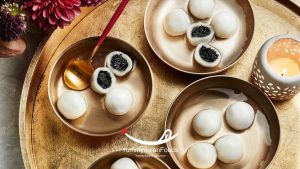
2. Egg Tarts (Dan Ta)
Egg tarts, also known as “Dan Ta” in Chinese cuisine, hold deep cultural significance and a rich history in Chinese dessert tradition. Originating from Guangzhou, these delectable treats have become a staple in Chinese bakeries worldwide. The delicate balance of the flaky pastry and the creamy egg custard filling embodies the essence of dessert craftsmanship, and their popularity has transcended cultural boundaries, becoming a symbol of Chinese culinary artistry.
The flaky pastry of egg tarts, with its buttery layers and crisp texture, harmonizes perfectly with the luscious, smooth egg custard filling, creating a delightful contrast of flavors and textures. Whether enjoyed at home or in Chinese bakeries, savoring an egg tart is an experience to be cherished. For the ultimate indulgence, try warming the tarts before serving to enhance the pastry’s buttery aroma and the custard’s creamy richness, allowing you to fully appreciate the exquisite craftsmanship that defines this delicious Chinese dessert.
3. Red Bean Soup (Hong Dou Tang)
Red beans, also known as adzuki beans, are a staple ingredient in many Chinese desserts, including the popular Red Bean Soup (Hong Dou Tang). These small red beans are delicious and packed with health benefits. They are a great source of protein, fiber, and various vitamins and minerals, including iron, potassium, and magnesium. Consuming red beans may help lower cholesterol levels, improve digestion, and support heart health. Additionally, their antioxidant properties can help reduce inflammation and protect against certain chronic diseases. With its nutrient-rich profile, red bean soup is a comforting dessert and a nourishing treat for the body.
To create a comforting and nutritious red bean soup, rinse the red beans and soak them in water for a few hours or overnight to soften. Then, boil the red beans in a pot with water. Reduce the heat and let it simmer until the beans are tender. Add in rock sugar or a sweetener, and continue to cook until the soup reaches a smooth and creamy consistency. For serving, garnish the red bean soup with a drizzle of coconut milk for added creaminess and a sprinkle of toasted sesame seeds for a nutty flavor. This Chinese dessert can also be warm or chilled, making it a versatile and satisfying treat for any occasion.
4. Pineapple Cake (Feng Li Su) Chinese Dessert
Pineapple cakes, or Feng Li Su, hold significant symbolism in Chinese culture. These delectable treats are often given as gifts during special occasions, symbolizing luck, wealth, and prosperity. The intricate crisscross patterns on the top of the pastry represent these positive sentiments, making pineapple cakes a popular choice for Lunar New Year celebrations and weddings in Chinese tradition.
This dessert features a buttery, crumbly pastry that encases a sweet and tangy pineapple filling. The contrast of the melt-in-your-mouth pastry and the juicy, flavorful pineapple creates a delightful sensory experience. Enjoying pineapple cakes with a fragrant cup of Chinese tea enhances indulgence, making it a perfect accompaniment to a relaxing afternoon tea or a satisfying snack to savor the rich flavors of this traditional Chinese dessert.
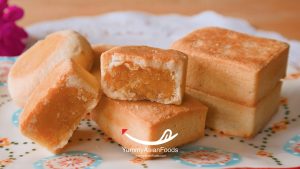
5. Grass Jelly Dessert (Leung Fan Gou)
Grass jelly, known as Leung Fan Gou in Chinese herbal medicine, has long been valued for its cooling properties. In traditional Chinese medicine, it is believed to help balance the body’s internal heat, making it a popular ingredient in Chinese desserts aimed at promoting a sense of cooling and balance. The jelly’s unique texture and slightly herbal flavor make it a distinctive dessert component, adding a refreshing and light quality to the dish.
The texture of grass jelly is often described as smooth and slightly gelatinous, contrasting the sweet and refreshing flavors commonly found in desserts. Its subtle herbal taste adds an intriguing depth to dishes, making it a versatile ingredient for creating unique and delightful desserts. From incorporating grass jelly into traditional sweet soups to creating modern fusion desserts, there are endless possibilities for infusing this Chinese dessert with a cooling and rejuvenating quality.
6. Sweet Sesame Balls (Jian Dui)
Sweet sesame balls, known as Jian Dui in Chinese, have a rich historical background as traditional Chinese desserts. Originating from the Tang Dynasty, these delectable treats have been enjoyed for centuries and are an integral part of Chinese culinary culture. Jian Dui, with a crispy exterior made from glutinous rice flour and a sweet sesame paste filling, is a delightful combination of textures and flavors, making it a dessert enjoyed by people of all ages.
The crispy exterior of Jian Dui provides a satisfying crunch, while the sweet sesame paste filling offers a delightful contrast in both texture and taste. Variations, such as adding a hint of coconut or incorporating red bean paste, can be explored to add a unique twist to this classic Chinese dessert. Jian Dui can be served alongside a fragrant cup of Chinese tea to create a harmonious balance of flavors or enjoyed as a standalone dessert to satisfy a sweet craving. Whether served as a delightful accompaniment to tea or savored as a dessert, Jian Dui is a dessert that continues to captivate the taste buds of food enthusiasts worldwide.
7. Mooncakes (Yue Bing)
Mooncakes, a traditional Chinese dessert, are significant in the Mid-Autumn Festival celebrations. This festival, also known as the Moon Festival, is a time for family gatherings and paying homage to the full moon. Mooncakes symbolize reunion and are often exchanged as gifts between friends and family. The round shape of the mooncake represents completeness and unity, while the intricate designs on the surface often depict scenes from Chinese folklore or symbols of good fortune.
There are various types of mooncakes, each with its unique filling and pastry crust. Some popular fillings include lotus seed paste, red bean paste, and salted egg yolk, while the crust can be made from different types of dough, such as flaky, tender, or chewy. Additionally, there are modern variations of mooncakes with innovative fillings such as chocolate, ice cream, and even durian. When enjoying and gifting mooncakes during the festival, it’s important to consider the recipient’s preferences and dietary restrictions. It’s also customary to present mooncakes in decorative boxes as a token of appreciation and good wishes.
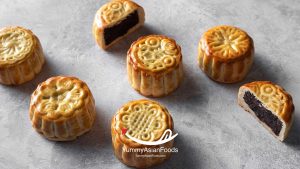
8. Coconut Milk Pudding (Yeung Ji Gook) Chinese Dessert
Coconut Milk Pudding, also known as Yeung Ji Gook, is a delightful Chinese dessert renowned for its creamy and refreshing nature. This delectable treat is made from coconut milk, giving it a rich and smooth texture while offering a hint of natural sweetness. The combination of the coconut milk and the delicate pudding base creates a luscious dessert that is both comforting and indulgent, making it a popular choice for those with a sweet tooth.
To make coconut milk pudding at home, you’ll need simple ingredients such as coconut milk, sugar, and agar powder. Begin by heating the coconut milk and sugar until the sugar dissolves, then add the agar agar powder and stir until it thickens. Once the mixture is ready, pour it into molds and refrigerate until set. For extra flavor, consider adding fresh fruit toppings, such as mango or lychee, to enhance this Chinese dessert’s overall taste and presentation. When serving, you can also sprinkle some toasted coconut flakes or drizzle a bit of honey for an added layer of sweetness and texture.
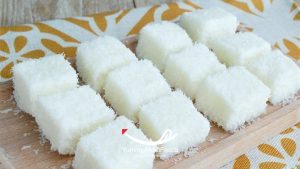
9. Almond Jelly (Xing Ren Dou Fu)
Almonds are renowned for their numerous health benefits, making them a popular choice for culinary and nutritional purposes. Packed with essential nutrients like vitamin E, magnesium, and fiber, almonds have been linked to improved heart health, weight management, and even reduced risk of certain chronic diseases. In addition to their nutritional profile, almonds contain antioxidants, which may help lower blood sugar levels. This makes them a valuable ingredient in the traditional Chinese dessert, Almond Jelly (Xing Ren Dou Fu), which combines the healthful properties of almonds with a delicate and refreshing texture.
Almond jelly, a delicious Chinese dessert, is a delightful delicacy characterized by its smooth and subtly sweet almond flavor. This chilled, gelatinous dessert is often served with a drizzle of sweetened condensed milk, adding a touch of creaminess to its refreshing taste. Beyond enjoying almond jelly on its own, it can also be creatively incorporated into other desserts, such as fruit salads and parfait cups, or even used as a filling for pastries. For a standalone treat, consider serving almond jelly with fresh fruit, coconut milk, or other traditional desserts for a delightful and satisfying end to a meal.
10. Taro Balls (Yam Balls)
Taro balls, also known as yam balls, hold significant cultural importance in Taiwanese cuisine. These chewy, earthy-sweet treats are commonly enjoyed as a traditional Chinese dessert, particularly during festive occasions and celebrations. The use of taro in Taiwanese cuisine dates back centuries and is deeply rooted in the island’s agricultural history, making taro balls a symbol of cultural heritage and culinary tradition.
The chewy texture and earthy-sweet flavor of taro balls make them a delightful addition to any Chinese dessert spread. Their soft yet slightly firm consistency provides a satisfying mouthfeel, while the natural sweetness of taro adds a comforting and familiar taste. Taro Balls can be served in various ways, such as in warm sweet soup or alongside creamy shaved ice, offering a delightful and refreshing treat for those seeking a unique and authentic Taiwanese dessert experience.
11. Nian Gao (年糕, Chinese New Year Cake)
Nian Gao, or Chinese New Year Cake, is a traditional Chinese dessert made from sweet glutinous rice flour. This sweet and sticky cake is essential to Lunar New Year celebrations, symbolizing good luck and prosperity for the coming year. It is often enjoyed as an auspicious treat during this festive time, with its rich and indulgent texture making it a favorite among families and friends gathering to usher in the new year.
As a beloved Chinese dessert, Nian Gao holds a special place in the hearts of those celebrating the Lunar New Year. Its significance goes beyond its delicious taste, as it is believed to bring blessings and good fortune to those who consume it. Whether steamed, fried, or added to savory dishes, this sweet rice cake is a cherished delicacy that adds a touch of sweetness and symbolism to the joyous festivities of the Chinese New Year.
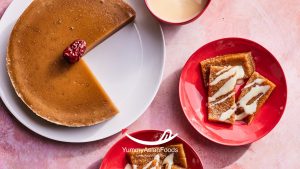
Conclusion: 11 Chinese Dessert Treats That Are So Delicious
These 11 Chinese dessert treats offer a delightful exploration of flavors, textures, and cultural significance. Whether you are craving something sweet, creamy, or refreshing, there’s a perfect dessert to satisfy your cravings!


